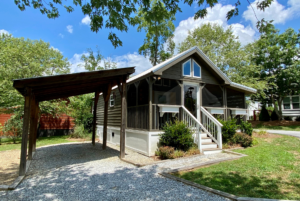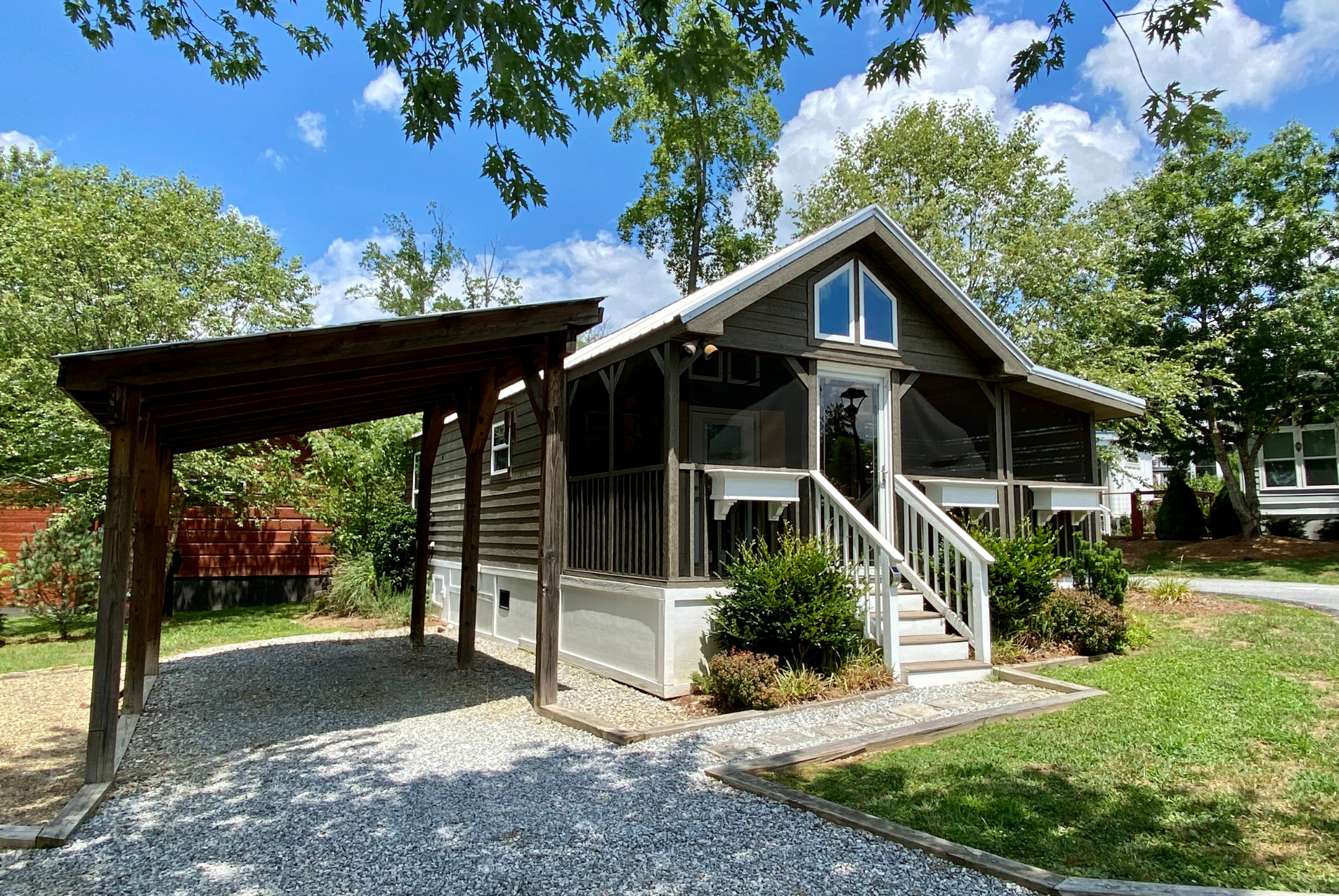Park model homes have grown in popularity over the years, and rightfully so! These homes offer the best of both worlds, as they are classified as RVs but are built to be durable and sturdy like ordinary homes. Whether you use them for seasonal living or even as a vacation home, these can be excellent properties that you and your family will enjoy for many years to come.
However, with any property, you need home insurance. Getting park model home insurance is inexpensive compared to ordinary home insurance and can bring you peace of mind and financial protection. In this article, we’ll explore more about park model home insurance, what the differences are between this type of insurance and others, and how you can choose the right policy. Let’s first explore more about what this type of insurance is and why it matters.
What is Park Model Home Insurance?
Park model home insurance is specifically designed for your park model home. Like other real estate insurance companies, your premium will be determined based on a few factors, including the location of your home, the home value, its condition, your coverage, your deductible, claims history, and any discounts you can earn for bundling your policies or for your customer loyalty. In most cases, you’ll find that park model insurance is around $1,500 per year!

How Does Park Model Home Insurance Differ from Other Insurance Types?
Unlike ordinary home insurance, your park model home insurance differs in a few ways. First, park model homes are typically categorized as trailers, RVs, or even mobile homes. The selected categorization will determine the extent and specificity of your park model home coverage. For instance, trailer insurance will allow you to add the home to your insurance during transport temporarily but does not cover any damage to the trailer itself.
On the other hand, if you have RV insurance for your park model home, you’ll enjoy similar coverages that an RV would enjoy while parked, but transportation is not always covered. Finally, if you have mobile home insurance, these insurance plans differ and have varying levels of coverage. Typically, your park model home would be classified under this type of policy as long as it is a semi-permanent structure. You’d likely qualify for this policy if you live in Simple Life’s North Carolina communities.
The Main Differences Between Park Model Home Insurance and Regular Real Estate Insurance
Comparing both park model home insurance and regular home insurance, here are the main differences you’ll notice:
- Size and Mobility: Generally speaking, park model homes will only cover up to 400 square feet of space, or up to 499 square feet in Florida. Additionally, insurance plans might also cover transportation for park model homes, whereas regular real estate insurance covers more extensive square footage and no transportation.
- Legal Classifications: In many parts of the country, you’ll find that park model homes are classified as recreational vehicles. However, real estate insurance plans for ordinary homes are typically subject to different licensing and zoning distinctions.
- Types of Risk Covered: With a park model home, you will have different risk profiles due to the home’s location, especially if it is treated as an RV. Ordinary home insurance will not include clauses about transportation risks.

Why Do You Need Park Model Home Insurance?
Just as you need home insurance for your permanent residences, you’ll also need insurance for your park model home. Not only will you need protection from natural disasters like fires, storms, and floods, but you may also be in an area where wildfires and hurricanes are more probable than not. In the event of these disasters, having home insurance will save you and your family and help you cover the cost of repairs, replacement items, and more.
Home insurance for your park model home also covers issues like theft and vandalism. Without this necessary policy for your home, you might have to pay costly repairs to restore your home to its original splendor. There are also certain liability risks that you must account for, like accidents or injuries on your property. The last thing you want to do is be surprised with medical bills after someone falls down the stairs!
What Types of Coverage Are Available?
If you’re on the lookout for park model home insurance, you have several different options to choose from. You must find a plan that best fits your needs and supports you in the event of a natural disaster or accident. Here are some types of coverage you might opt for:
- Property Coverage: As required in most insurance plans, this park model home coverage includes protection for structural damage and personal belongings inside the home.
- Liability Coverage: If you are sued for damage or injuries on the property, this coverage will help you cover the cost of any medical payments for those injured on the premises.
- Loss of Use Coverage: For those who are unable to live in their park model home temporarily, this coverage will help you pay for the cost of renting a house or staying in a hotel until it is safe to return.
- Specialized Add-Ons: Depending on the company that you choose, you can add specialized coverage for specific natural diseases or even extra coverage for expensive jewelry and electronics.
How Do I Choose the Right Policy?
When it comes to selecting the right policy for your new park model home, you will have many companies to choose from. However, it is essential to take a few steps to identify the best plan for your property.
- Assess Your Needs: Before you talk to companies, understand the value of your home, its contents, and the risks of your specific location.
- Compare Providers: Do not go with the first insurance company you find. Instead, browse providers specializing in park model home insurance and note their reviews and ratings.
- Understand the Policy: Never sign on the dotted line until you fully understand your policy. Be sure to read the fine print, including deductibles, limits, and exclusions. You might find that wear and tear and pest damage are not included!
- Consult with an Agent: When in doubt, seek professional advice. They can help you determine what the best policy would be, and they may even be able to help you create your own park model home coverage plan.
Tips for Lowering Your Premium
Congratulations! You have found your policy, but how do you lower your premium? Fortunately, we have a few tips that you can use to reduce your park model home insurance cost. First, increasing your deductibles is always a good idea, as this can lower your premium cost. Additionally, installing safety features like fire alarms and smoke detectors can also reduce your insurance costs.
Another step that you can take is to improve your credit score, as a higher credit score can lead to lower rates. Others have found that regular policy reviews can lower their costs, as can staying claims-free. If you follow these tips, your park model home insurance will be as low as possible!

How to Recover After a Loss or Damage to Your Park Model Home
If you have suffered from a loss or your property has sustained damage, then there are a few steps you need to take immediately to remedy the situation. First, you need to ensure your safety and contact the authorities. From there, you should document every bit of the damage with detailed notes and photos. If required, you should also work to secure your property to prevent further issues.
After this, you should file a claim with your insurance provider. You can get the claim files quickly with the necessary documentation and details. It’s best to provide police reports, repair estimates, photos, and notes of what happened. Then, you obtain repair estimates, work with your insurance company to process your claim, and return your home to its original state!
Take Steps to Protect Your Park Model Home
Now that you know a bit more about park model home insurance, you can take steps to protect your home or seasonal property. With the right park model home coverage, you’ll prepare your family for any accident or disaster that might arise. If you’re looking for a new park model home to call home, why not choose Simple Life?
With several amenities and floorplans to choose from, Simple Life has multiple communities. Once you find your home, our team can happily provide recommendations for your park model home coverage so you and your family can get settled and enjoy a relaxing lifestyle. Visit our website today to find your new home!
Frequently Ask Questions (F.A.Q.)
Is a park model a good investment?
A park model can be a good investment if you’re looking for an affordable, portable housing option that offers access to nature and recreational activities.
What is not covered by RV insurance?
RV insurance typically does not cover personal belongings inside the RV, damages caused by negligence, or certain types of natural disasters.
What is the best insurance company for a mobile home?
The best insurance company for a mobile home often depends on individual needs, but companies like Geico, Allstate, and State Farm are frequently recommended for their coverage options and customer service.
Is it hard to finance a park model?
Financing a park model can be challenging due to factors like credit requirements, location, and lender policies, but multiple options are available.
Do park models depreciate?
Yes, park models typically depreciate in value over time, similar to other types of manufactured homes.





